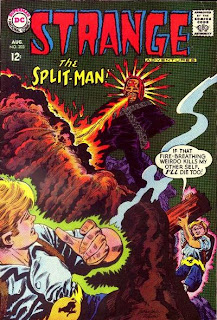 Superman's Girl Friend Lois Lane #77
Superman's Girl Friend Lois Lane #77 (On Sale: June 29, 1967), AKA
80pg. Giant #G-39, features a
Kurt Schaffenberger cover and follows the theme
Lois' Greatest Shockers! The release date on this is highly suspect to me, as
Superman's Girl Friend Lois Lane #76 went on sale two days earlier.
Inside we have
"The Witch of Metropolis" from
Superman's Girl Friend Lois Lane #1 by
Otto Binder and
Kurt Schaffenberger. Lois Lane is exposed to fumes from an experiment by Professor Jason. The fumes cause Lois to change into an old hag each night. Lois thinks she has become a witch, so she casts spells.
Next is
"Lois Lane -- Convict" from
Superman's Girl Friend Lois Lane #6 by
Kurt Schaffenberger. Lois Lane takes a bribe from a mob boss. He wants her to hold off writing a story exposing him. She is forced to keep working for the mob when they blackmail Lois with a photo of her taking the bribe. Lois is eventually sent to prison for using marked money from a crime. Lois confesses to taking the bribes.
The mob springs Lois from jail and takes her to the mob leader, Baldy Pate. Pate forces Lois to tell him where the evidence she was going to expose is located.
Next we have
"The Six Lives of Lois Lane" from
Action Comics #198 by
William Woolfolk, Wayne Boring and
Stan Kaye. After Lois Lane witnesses Superman change into Clark Kent in front of a mirror, Lois’s mind goes into shock. For the next few days, Lois believes she is a different historical figure. Lois takes on the personas of Betsy Ross, Florence Nightingale, Annie Oakley, Madam Curie, Barbara Frietchie, and Queen Isabella of Spain. Superman seeks to restore Lois’s mind, but is fearful she will remember discovering his secret.
The next story is
"The Mad Woman of Metropolis" from
Superman's Girl Friend Lois Lane #26 by
Kurt Schaffenberger. Lois Lane receives a tip to meet one of Clark Kent’s informants. When she arrives she is knocked unconscious. She revives, but Clark can not back up her story, so she thinks the bump on the head causes her imagination to go wild.
Later, Lois is convinced that she has unconsciously destroyed a Superman poster. Worried about her erratic behavior, Lois visits a psychiatrist who convinces her to read a book to take her mind off her problems. Lois feels better, but when Clark looks at the book it has blank pages.
Lois is convinced she has gone crazy, and a voice tells her to kill herself.
Next is
"Lois Lane's X-Ray Vision" from
Superman's Girl Friend Lois Lane #22 by
Kurt Schaffenberger. Lois Lane’s sunglasses become exposed to some strange electrical energy which enables the wearer to gain x-ray vision. Lois uses the ability to get a scoop, but the new power allows her to see Superman’s costume under Clark Kent’s clothing. Superman learns of the ability of the enhanced glasses and arranges for Lois to lose them.
Later at the Daily Planet office, Superman, as Clark, pretends to have found them. Just as Lois begins accusing Clark of being Superman, an escaped con bursts in and shoots Clark.
Next we have
"The Ghost of Lois Lane" from
Superman #129 by
Jerry Coleman, Wayne Boring and
Stan Kaye. While Lois is in Professor Grail's laboratory covering a story, Superman uses his X-ray vision to find the Professor. His X-Ray vision sets off a machine that sends Lois into the 4th dimension. The machine explodes leading Superman to believe Lois is dead.
Every time Superman uses his X-ray vision he can now see Lois. He believes that Lois is haunting him because of what he did.
Next is
"Lois Lane's Darkest Secret" from
Superman's Girl Friend Lois Lane #25 by
Kurt Schaffenberger. While trailing a movie actress, Lois Lane learns that the employees of a hair salon are using truth gas on their customers and then blackmailing them with their secrets. Lois contacts the actress, Sandra Thorne, and tries to catch the crooks in the act. However, they do not show up forcing Lois to return to the salon.
Lois undergoes the truth gas treatment, but she has taken the antidote. She tries to trick the blackmailers but they learn of her plot. The crooks gas her at her home and force her to reveal the existence of a Kryptonite meteor.
The final story is
"The Fattest Girl in Metropolis" from
Superman's Girl Friend Lois Lane #5 by
Otto Binder and
Kurt Schaffenberger. Lois is the only witness to a murder. She is unable to identify the killer from mug shots, so she fears he will come after her. While visiting Professor Colby, Lois is exposed to a growth ray that causes her to become fat. Lois is embarrassed by her weight and avoids Superman.
Edited by
Mort Weisinger.
 These are odd. Some of the September comics came out at the end of June, so here are some I previously missed...
These are odd. Some of the September comics came out at the end of June, so here are some I previously missed...












































